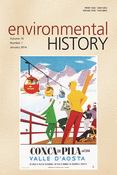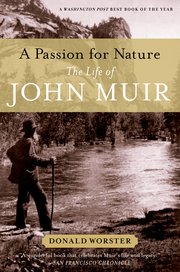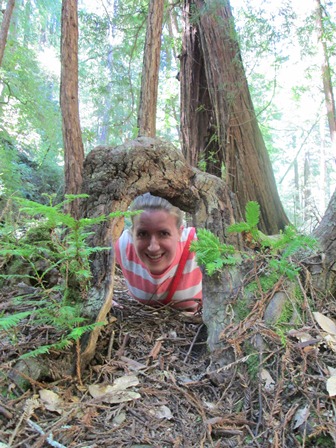
By Elyse Turr
San Francisco, here we come.
Oxford is excited for the upcoming annual conference of the American Society for Environmental History in San Francisco this week: 12-16 March 2014. The theme of the conference is “Crossing Divides,” reflecting the mixed history of the discipline and California itself.
We’ll be at the Opening Reception, co-sponsored by Oxford University Press, MIT, University of Delaware, and the Winslow Foundation on Wednesday, 12 March 2014 from 6:00-8:00 p.m. in the Cyril Magnin Ballroom.
Stop by Oxford’s display in the Exhibit hall. We’ll have hundreds of books on display, including several hot off the presses like Jared Orsi’s Citizen Explorer: The Life of Zebulon Pike, Cecilia M. Tsu’s Garden of the World: Asian Immigrants and the Making of Agriculture in California’s Santa Clara Valley, and Kendra Smith-Howard’s Pure and Modern Milk: An Environmental History since 1900.
 Pick up a complimentary copy of Environmental History and other key Oxford journals at the booth. The most current issue features new articles on the environmental history of work, environmental politics and corporate real estate development, the shift to steam power in water reservoirs, and how skiing transformed the Alps. The editors have also compiled a special conference-companion virtual issue that draws on the theme of “Crossing Divides.” And for your teaching and research needs we’re offering free trials of Oxford’s online resources. Check out census data going back to 1790 with Social Explorer or assign sections, chapters, or full texts of books with Oxford Scholarship Online. Pick up a free trial access card at the booth.
Pick up a complimentary copy of Environmental History and other key Oxford journals at the booth. The most current issue features new articles on the environmental history of work, environmental politics and corporate real estate development, the shift to steam power in water reservoirs, and how skiing transformed the Alps. The editors have also compiled a special conference-companion virtual issue that draws on the theme of “Crossing Divides.” And for your teaching and research needs we’re offering free trials of Oxford’s online resources. Check out census data going back to 1790 with Social Explorer or assign sections, chapters, or full texts of books with Oxford Scholarship Online. Pick up a free trial access card at the booth.
 ASEH 2014 is offering a number of field trips, but the one we’re fired up about is a field trip to Muir Woods on Friday, 14 March 2014. In 2008 Oxford was proud to publish Donald Worster’s biography of John Muir, A Passion for Nature: The Life of John Muir. Worster discusses Muir’s appreciation for and belief in the power of the forest in this passage:
ASEH 2014 is offering a number of field trips, but the one we’re fired up about is a field trip to Muir Woods on Friday, 14 March 2014. In 2008 Oxford was proud to publish Donald Worster’s biography of John Muir, A Passion for Nature: The Life of John Muir. Worster discusses Muir’s appreciation for and belief in the power of the forest in this passage:
“Nature, particularly its forests, offered an ideal of harmony to a nation torn apart by conflict between capital and labor, country and city, imperialists and anti-imperialists. That harmony was first and foremost one of beauty; nothing in nature was ugly or discordant, a lesson that could be learned by hiking a trail into the Sierra or standing at the rail of a steamer along the Alaskan coast. The challenge was how to help American society achieve that same degree of moral and aesthetic unity.
“Violent confrontation was not the way to achieve ecological harmony, a beautiful landscape, or a decent civilization. One must start by resolving to conserve the natural world for the sake of human beings and other forms of life. Conservation offered both an economic and aesthetic program of social reform—learning to use natural resources more carefully, for long-term renewability, and learning to preserve wild places where humans could go to learn about how nature constructs harmony. Muir tried, as other green men did, to push conservation in both directions. Achieve these reforms, he believed, and a truer, better democracy would evolve in which people of diverse origins, abilities, and needs would live in greater peace and mutuality, just as all the elements of nature did. If a forest could thrill the sense and still the troubled heart with its harmonies, then society could become like that forest. Such was the hope of the green men.”
—Donald Worster, A Passion for Nature: The Life of John Muir
My own first experience in Muir Woods:
I grew up in the Northeast –I’ve tapped maples looking for sap, hiked portions of the Appalachian Trail and spent enormous chunks of my childhood climbing the pine tree in our front yard–I thought I knew trees. Last Spring, while visiting friends in San Francisco, we toured Muir woods and I very quickly realized that any of the previous trees I knew were mere twigs by comparison to the majestic redwoods. It was both powerful and humbling to be among these giants, feeling dizzy trying to find their tops and small trying to wrap my arms around one and not even getting half-way. Never before had I been able to step inside a fire-charred redwood or run my hands across the hundreds of rings in a fallen tree. Muir Woods is a beautiful, peaceful place and I am very glad I was able to experience it; it was an experience I will always remember.
—Elyse Turr, History Marketing

Elyse Turr in Muir Woods
See you in San Francisco!
Elyse Turr is an Assistant Marketing Manager for history titles for Oxford University Press.
Subscribe to the OUPblog via email or RSS.
Subscribe to only American history articles on the OUPblog via email or RSS.
The post Preparing for ASEH 2014 in San Francisco appeared first on OUPblog.

by Cassie, Publicity
Patricia Fara lectures in the History and Philosophy of Science at the University of Cambridge and is the Senior Tutor of Clare College. In her latest book, Science: A Four Thousand Year History, she sweeps through the centuries, from ancient Babylon right up to the latest cutting-edge research in genetics and particle physics, illuminating the financial interests, imperial ambitions, and publishing enterprises that have made science the powerful global phenomenon that it is today. In this original article, she discusses global warming and the history of environmentalism.
As a topic for comic verse, global warming might not seem the ideal choice. However, Howard Nemerov, who used to be Poet Laureate of the United States, would not have agreed. In 1989, he wrote this eloquent reminder that scientific progress can have its drawbacks:
praise without end the go-ahead zeal
of whoever it was invented the wheel;
but never a word for the poor soul’s sake
that thought ahead, and invented the brake.
Twenty years later, as the icecaps melt and famine rates increase, it seems obvious that politicians and scientists should long ago have called a halt to industrial processes that made their own lives more comfortable, but pushed the world towards destruction. Unfortunately, winding back the clock has never been as straightforward as it sounds. In the middle of the eighteenth century, when Europeans first started wandering around Tahiti, the French explorer Louis de Bougainville enthused ‘I was transported into the Garden of Eden; we crossed a turf, covered by fine fruit trees, and intersected by little rivulets…everywhere we found hospitality, ease, innocent joy, and every appearance of happiness.’ Before long, this earthly paradise had been irreversibly corrupted by sexually transmitted diseases and imported technological gimmicks.
Current concerns about our planet’s survival have refueled romantic visions of a vanished golden age when natural harmony reigned, unthreatened by ozone holes or vanishing species. However, preserving environmental purity entails confronting some paradoxes. For one thing, much of nature is unnatural: scenes that seem eternal are man-made products. Britain, for example, was originally covered in dense woodland, and bore little resemblance to the open pastures featured in publicity brochures. Large fields were created only in the eighteenth century, when wealthy landowners decided to make their farms more profitable by obliterating the small strips of land allocated to individual families. Far from being conservationists, these agricultural reformers overrode protests about decimating traditional village life in order to create the meadows that now characterize picture-book Britain.
Safeguarding the environment might seem a universal ideal, but it is a political issue that has been adopted by very different factions. During World War Two, when British propaganda campaigns were urging loyal citizens to defend their supposedly traditional countryside, the nations’ enemies were summoning up nature to back the Nazi cause. Adolf Hitler was a nut-cutlet vegetarian whose regime reforested arable land, dispensed organic herbal medicines, and instigated research programmes into natural therapies. His right-hand aide Hermann Goering is now deplored for founding the Gestapo and the concentration camps, but he was also a pioneer environmentalist. After Poland’s original woodlands were devastated by the German Occupation, Goering restocked its newly created parks with the animals that had once been native, including a herd of superb bison – a potent Teutonic emblem – bred according to the latest techniques of post-Darwinian eugenicists. Despite the genocidal campaigns he launched against human beings, Goering insisted that this primeval forest was a sacred grove whose animal inhabitants should remain untouched.
Nature looks better when it is artificial. That is why the gardener Capability Brown fabricated tranquil English landscapes by digging lakes, planting trees and moving whole villages – including their inhabitants. The naturalist John Muir was enraptured by the serene Californian meadowlands he visited, but he chose to ignore the influence of native American farmers who had been fire-clearing the original forest for centuries. The artist James Audubon made a small fortune by selling exotic pictures of birds, carefully crafting them in his studio to symbolise American values of strength and freedom as they soared against painted backdrops of remote mountains. Yet Audubon was no conservationist, but a keen huntsman who obsessively tracked down the rarities he needed to complete his collection, not caring about the risks of extinguishing threatened species.
The appeal of wild nature is relatively recent. For millennia, wilderness was something to push back and overcome as people struggled to carve out a comfortable existence from their hostile surroundings. Survival depended on taming nature, so that barren mountains and dense forests were regarded as suitable for social outcasts, for sinners banished from God’s Garden of Eden. Such harsh domains started to become fashionable only a couple of hundred years ago, when the products of civilisation were starting to seem less attractive. Romantic travelers described how they reached states of near-religious ecstasy through contemplating the sublime beauty of precipitous gorges or gloomy cathedral-like groves. After venturing overseas to other continents, they recounted that they had voyaged back in time, encountering primitive societies where life was easier and purer.
This double yearning for the sublime and the primitive manifested itself particularly strongly in the United States. During the nineteenth century, romantic writers envisaged pioneers steadily pushing back the frontier between the wild and the civilized as they moved ever westwards. This triumphant vision was marred by nostalgic regrets that Americans were losing contact with their immigrant origins as progress obliterated the authentic experiences of the first rugged settlers. To resolve this sentimental dilemma, enterprising naturalists established national parks with a double purpose—to provide sanctuaries for refugees from successful capitalism, and to stand as monuments to America’s pioneering spirit.
Most famously, Muir—originally a farmer born in Scotland, nowadays celebrated as the founding father of environmentalism—set about converting Yosemite into a man-made wilderness zone. He intended his national park to appear primal, even though it had never before existed as he designed it. Apparently oblivious to the inherent ironies of their mission, Muir and his contemporaries worked with biblical zeal, aiming not to simulate the grim realities of frontier survival, but instead to resurrect the original Garden of Eden. But manufacturing uninhabited glades of harmony meant forcibly clearing out the indigenous residents, many of whom were slaughtered or subjected to misery in reservations. To guarantee safe access and stop nature from ruining the carefully selected views, conservationists constructed discreetly camouflaged tracks and embarked on continuous maintenance programmes.
Restoring an imagined natural past has always been an expensive business. It also entails interference and oppression—ejecting Native Americans from Yosemite, ripping out family strip-farms, relocating villages. Nowadays, privileged eco-tourists who live in cities campaign to preserve endangered species and keep vast tracts of untamed nature as retreats from urban pressures. Maintaining bio-diversity may seem a more worthwhile and more scientific ideal than Muir’s bid for an original terrestrial paradise. Nevertheless, just as in Yosemite, establishing uninhabited wilderness has entailed evicting the local inhabitants. In the interests of preservation, many victims of involuntary resettlement—Thai, Kenyans, Amazonian Indians—have become conservation refugees confined to shabby squatter camps.
The central paradox is that people are themselves part of nature. In 1964, American conservation law defined wilderness as a place ‘where man himself is a visitor who does not remain’—but if people are excluded from nature, then it is intrinsically artificial. In the Bible, God gave human beings a dual responsibility—to be the world’s custodians, but also to exploit it for their own benefit. To express this conflict in scientific terms, the drive to conserve is at odds with the competitive struggle for survival entailed in human evolution. During the second half of the nineteenth century, wealthy capitalists justified their cut-throat tactics through invoking the mantra coined by Darwin’s disciples—’survival of the fittest’. However, the very success of this ruthless formula prompted critics to focus on its flip-side of exploitation, and in Germany, a very different Darwinian champion appeared—Ernst Haeckel. While American environmentalists were attempting to resurrect uncorrupted paradise, Haeckel was initiating a less oppressive, more holistic approach to biology that strongly influenced later environmentalist movements.
The science of ecology was founded by Haeckel, who invented the word in 1866. Although it has now acquired a moral spin—ecological washing-powder is virtuous as well as expensive—ecology started out as the study of the relationships between living creatures and their surroundings. Like ‘economy‘, it comes from the Greek word for a family household, and Haeckel suggested that all the Earth’s organisms co-exist as a single integrated unit, competing against each other but also offering mutual aid. According to Haeckel’s version of Darwinian evolution, if people are to flourish, then they should respect the laws of this universal system instead of trying to dominate it. If more people had listened to him, perhaps global warming would not be the world’s greatest challenge confronting the human race today.


 Pick up a complimentary copy of Environmental History and other key Oxford journals at the booth. The most current issue features new articles on the environmental history of work, environmental politics and corporate real estate development, the shift to steam power in water reservoirs, and how skiing transformed the Alps. The editors have also compiled a special conference-companion virtual issue that draws on the theme of “Crossing Divides.” And for your teaching and research needs we’re offering free trials of Oxford’s online resources. Check out census data going back to 1790 with Social Explorer or assign sections, chapters, or full texts of books with Oxford Scholarship Online. Pick up a free trial access card at the booth.
Pick up a complimentary copy of Environmental History and other key Oxford journals at the booth. The most current issue features new articles on the environmental history of work, environmental politics and corporate real estate development, the shift to steam power in water reservoirs, and how skiing transformed the Alps. The editors have also compiled a special conference-companion virtual issue that draws on the theme of “Crossing Divides.” And for your teaching and research needs we’re offering free trials of Oxford’s online resources. Check out census data going back to 1790 with Social Explorer or assign sections, chapters, or full texts of books with Oxford Scholarship Online. Pick up a free trial access card at the booth. ASEH 2014 is offering a number of field trips, but the one we’re fired up about is a field trip to Muir Woods on Friday, 14 March 2014. In 2008 Oxford was proud to publish Donald Worster’s biography of John Muir, A Passion for Nature: The Life of John Muir. Worster discusses Muir’s appreciation for and belief in the power of the forest in this passage:
ASEH 2014 is offering a number of field trips, but the one we’re fired up about is a field trip to Muir Woods on Friday, 14 March 2014. In 2008 Oxford was proud to publish Donald Worster’s biography of John Muir, A Passion for Nature: The Life of John Muir. Worster discusses Muir’s appreciation for and belief in the power of the forest in this passage:


